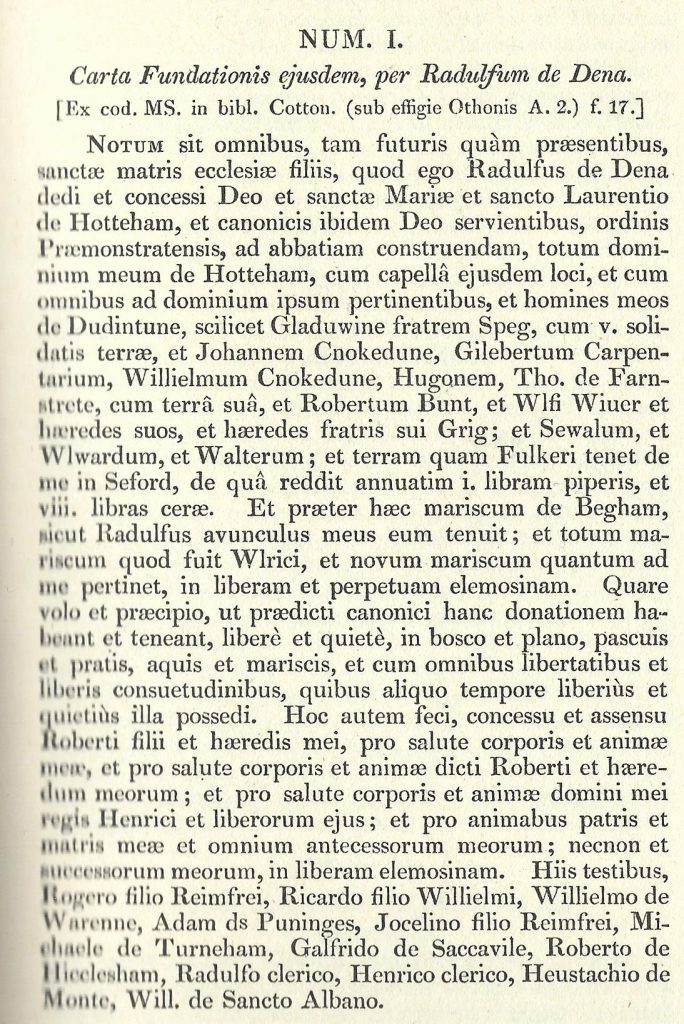ORIGINS AND FOUNDATION
The Premonstratensian abbey of Otham was founded by Ralph de Dene, a tenant of Gilbert d’Aigle, Lord of Pevensey, around 1180-83. It is thought that the convent originated from Durford Abbey near Petersfield.
There is no chartulary for Otham as such, but the chartulary for Bayham begins with charters that are exclusive to Otham. The first such, given in Dugdale (NUM 1. P. 911), states: ‘ …. that I, Ralph de Dene, gave and granted to God and to St. Mary and St. Laurence of Otham, and to the canons of the Premonstratensian order serving God in that place, to build an abbey, all my demesne of Otham, with the chapel of the same place and with all belonging to the demesne itself …’

It seems, then, that there was a pre-existing chapel dedicated to St Laurence, and served by Premonstratensian canons, already at Otham. The foundation date for the chapel is not known – it may be ancient and it may have been a powerful attraction to this group of canons from Durford seeking a propitious location.
HISTORY
In addition to the manor of Otham, the new foundation was endowed with lands at Dudington, Tilton, Ambefield, Hellingly and Yeldelond. However, the lands were poor and unproductive and the new abbey site soon proved unviable – It is recorded that: Propter magnus et intolerabiles inedias loci de Otteham [Because of the great and intolerable famine of the place of Otteham] – the canons applied to their founder’s daughter, Ela de Saukevile, to authorise their removal to a better place.
The Sussex VCH states: ‘The bleak and unhealthy situation of Otham, out in the marshes and even now hardly accessible in winter, and the poorness of their endowments soon rendered life so unbearable that the canons began to consider the desirability of removing; the first site offered was the church of Hellingly, … however, Sir Robert de Turnham began to build an abbey at Bayham on the borders of Kent and Sussex, and Ela de Sackville, as patroness, gave leave for the transference of the canons from Otham thither. This cannot have taken place before 1208, as Jordan, the only known abbot of Otham and first abbot of Bayham, was still abbot of Otham in December, 1207.
The Otham community were joined at Bayham by canons from Brockley Abbey (now in Lewisham, London) who had similarly failed with their initial foundation (c.1182).
The lands at Otham now became the property of Bayham and the Otham abbey site became a grange. There is no record of the fate of any monastic buildings on the site, although they cannot have been extensive after only c. 25 years of occupation – all in reduced economic circumstances. The original buildings presumably served the grange until they deteriorated and more appropriate accommodation was provided. Presumably, St Leonard’s chapel was maintained throughout … in 1404, when the abbot of Bayham let the manor of Otham to Henry Baker and John Drew, special reservation was made of all the offerings at the altar there, and of the image of St. Laurence in gold, silver, and wax, as well as of a room and stable with free access when required by the canons.
The chapel that survives at the abbey site is thought to be mid-fourteenth century in date – it may be a rebuild of the pre-existing chapel of St Laurence which drew the canons to the site in the first place.
DISSOLUTION
Bayham Abbey was amongst the twenty-nine houses chosen by Cardinal Wolsey for dissolution in 1526, to fund his new schools and colleges in Ipswich and Oxford. The manor of Otham was granted to Sir Edward Guildford in 1533. The chapel at Otham seems to have been in use as a parish church at the time of the dissolution and was allowed to continue in that use for another twenty years or so before closure.